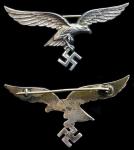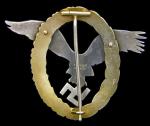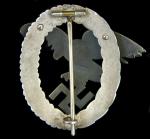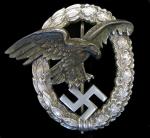-
Posts
3,397 -
Joined
-
Last visited
-
Days Won
3
Content Type
Profiles
Forums
Blogs
Gallery
Events
Store
Everything posted by J Temple-West
-
Hi John, Going on the two stripes and what appears to be a report book placed in the jacket, the ?Feldwebel? shown in post #4 is in fact "Der Spiess" (The Spear) affectionately known as "Die Mutter die Kompanie" (Mother of the Company.) So, no ordinary NCO. The link will take you to a couple of photographs showing this rank. http://gmic.co.uk/index.php?showtopic=1583...st=0#entry12272
-
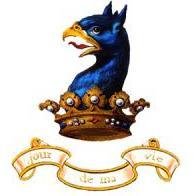
Heer My Heer photos
J Temple-West replied to usairforce's topic in Germany: Third Reich: Uniforms, Headwear, Insignia & Equipment
What a wonderful selection of photographs, usairforce. Training, off duty activities, uniforms, parades, even the ladies. It?s collections like this that give us not only insight into the life of members of the Wehrmacht, but are also so important as reference material. Thanks for taking the time to post them. -
A little but this eagle interests me. Thinking that I'd seen this maker before, I looked through the collection and found this one. Although also unmarked, it's made of silver and is only the second I've come across by this maker. It looks like there's a little research to do. Superb tunic, Bill. My compliments.
-
Having weighed and measured both P/O and PB, the stats above come well within tolerances for the both, except that my P/O is lighter (expected, due to it being an early example, materials used and the early wreath being thinner due to gilding as opposed to heavy plating.) The weight differences suggest to me that this badge is indeed an original Pilot?s badge that?s been taken apart, refinished and reassembled. I know it?s not proof positive but there is, in my mind, enough doubt where I would want to contact the dealer and ask for a refund. I think that's the right way to go, Stan.
-
A casting? I don?t think so?unless the ?Nasties? have perfected the art of creating stress fractures. No, my only concern is that the badge has been refinished. Yes, the rivets may well have been merely tightened, but it?s a red flag and this combined with the issue of the over all finish made me stop and take a closer look. Not one of those badges that immediately shouts?Yes, nice piece, no problems! Stan, as I?ve said, has this piece in-hand, we have only these photographs to go on. I would hope that if we had a different set of pix we would then all be able to go.. ahhhh! Yes, of course! That?s better! As it stands, I have a feeling that assessing this badge on these pix alone is going to divide opinion. To remove any doubt, I would like to see a better set of pix and, if possible, the dreaded weight and measurements?which I think will confirm that it?s not a cast copy. Over to you, Stan.
-
Hi Stan Absolutely no problem with the file cuts.. typical ?Juncker??But I have a few concerns. The badge just doesn?t sing out to me ?Nice original Juncker P/O? and makes me want to ask questions. ?Could this be a reworked Pilot?s badge?? This is me being overly cautious when I see a piece that?s (IMO) a little less than text book. The first thing that hit me when seeing this badge was the gilding. It?s probably the photography that makes it look matt, but I see no highlights on either wreath or eagle? The riveting.. Hard to tell from these close-ups but I?ve not seen these sloppy riveting marks/rivets on a Juncker P/O before, not that it means much, it may have been a bad day at the factory, or just that I haven?t come across many with these traits. The dark area on the swastika, between the eagle?s talons? found on pilot?s badges.. unusual for a P/O, especially one in this condition. You, of course, have it in hand and can see things that I can?t. Are any of these worries valid? Perhaps a shot in different lighting would help to allay any doubts. I post mine for comparison.
-
Just in (Thanks to Tim) this rather nice Observer?s badge by W.Deumer. Unlike its pre-war counterpart, this piece is made from parts supplied by C.E Juncker, Berlin and is a prime example of the collaboration between the two firms. The reverse shows that although the 2nd pattern, nickel silver wreath and eagle were supplied by ? Juncker?, ?Deumer? assembled the badge using their own style of riveting, hinge and catch.
-
Up until the 30th September 1936, those personnel who had previously been in the Army, had qualified for the army marksmanship awards (Schiessabzeichen) and were transferred to the newly formed Luftwaffe were permitted to continue to wear their army pattern marksmanship awards. From 30th September 1936, and on the introduction of the Luftwaffe marksmanship lanyard (Order LV 36, No. 1447) all qualified personnel were required to wear the equivalent of the new Luftwaffe lanyard ( Sch?tzenschnur). The new system, based on three lanyards, came in twelve grades. Grade 1 Cords: Blue-grey silk interwoven with aluminium threads. Shield: Dark oxidized. Acorn/Shells: None. Grade 2-4 Cords: As above. Shield: As Above. Acorns/Shells: 1 ? 3 dark oxidized in aluminium threads/metal. Grade 5 Cords: Aluminium threads interwoven with blue-grey silk. Shield: Bright aluminium. Acorns/Shells: None Grade 6-8 Cords: As above (Grade 5) Shield: As above (Grade 5) Acorns/Shells: 1 ? 3 in bright aluminium, threads/metal. Grade 9 Cords: Blue-grey silk interwoven with dark gold threads. Shield: dark gold. Acorns/Shells: None. Grade 10-12 Cords: As above (Grade 9) Shield: As above (Grade 9) Acorns/Shells: 1 ? 3 in dark gold threads/metal. Grade 9 lanyard
-
Die casting: Mainly used in the production of late-war badges, this process used molten metal injected into a die, under high pressure, to form the item. Shown below is a late-war Para badge by ?F.W Assmann? and is typical of the badges produced by the die casting process. All three techniques produced an extremely high quality product, having well defined features, few die flaws (although they do exist) and an obvious attention to detail. Badges found with blurred details, obvious air pockets, wrinkles or a line around the outer edge of the individual parts, from casting, usually indicate a reproduction, especially when a badge is purporting to be an early nickel silver, tombak/buntmetal example which has been ?die struck.?
-
Die Striking: Most commonly used in the production of Luftwaffe qualification badges, war badges of the Kriegsmarine and Heer. This method required a heavier sheet of metal, usually heated, to be placed between two die halves and the item was then produced under high pressure. Shown below is an early Observer?s Badge by ?F.W Assmann? and is typical of the badges produced by the die striking process.
-
Thanks for posting the pix, Dave...something I should have done! I've put together a little background on the different processes used in the production of TR badges...hope I've got it right! We'll get to your badge as soon as I get a minute. BTW, Is it possible to post some close-up's of the badge? Blowing up images isn't the best way of showing off the characteristics we need to point out. See what you can do. I can always replace the pix you've posted with new ones. Ok, a little background on the techniques used by award, medal and badge makers in the TR era. The three techniques used. Die Stamping: A process where an item was stamped out of a thin sheet of metal by placing it between two die halves. This method was used to produce hollow backed badges such as the 'Luftwaffe Helpers Badge' shown below.





